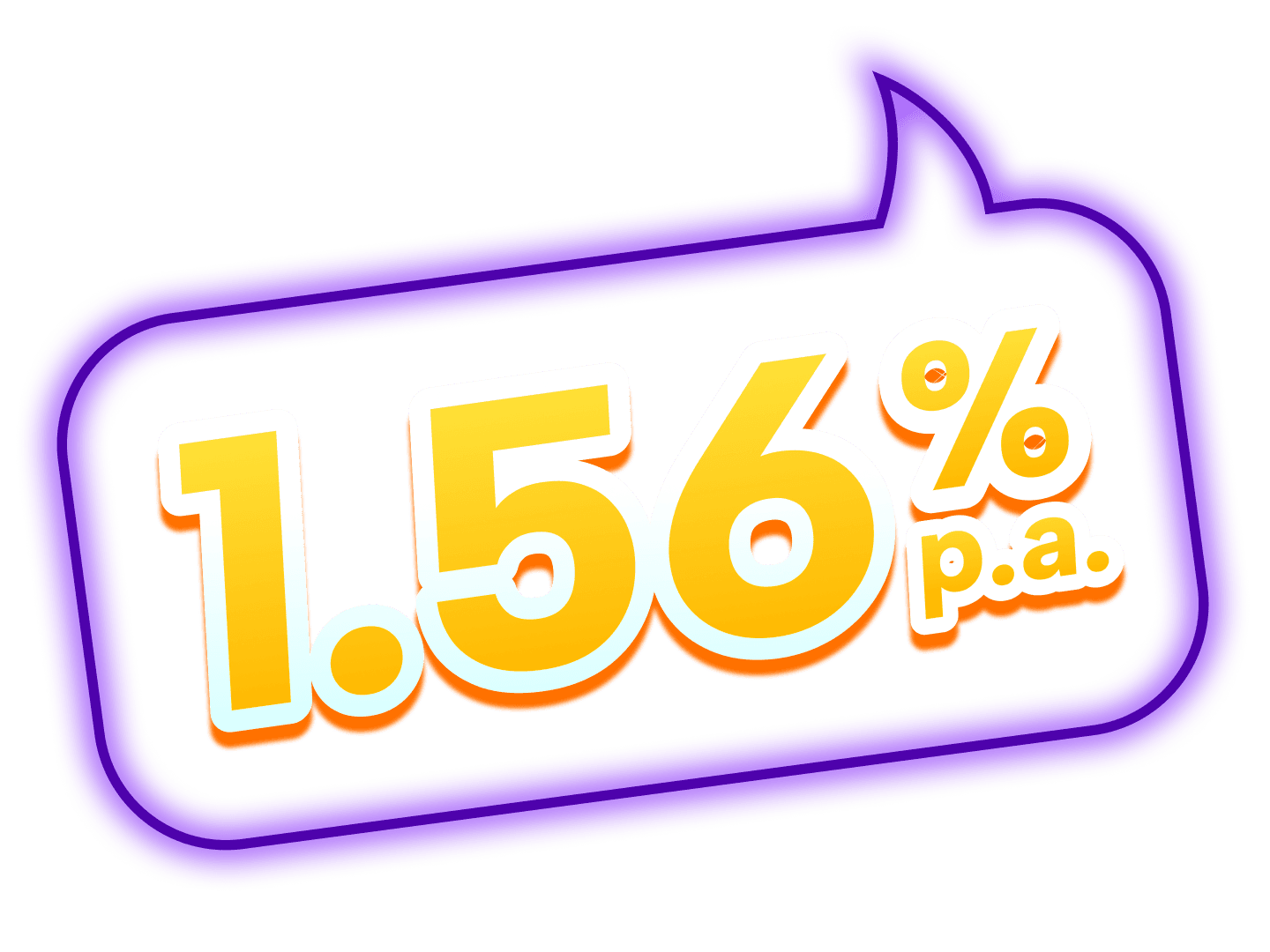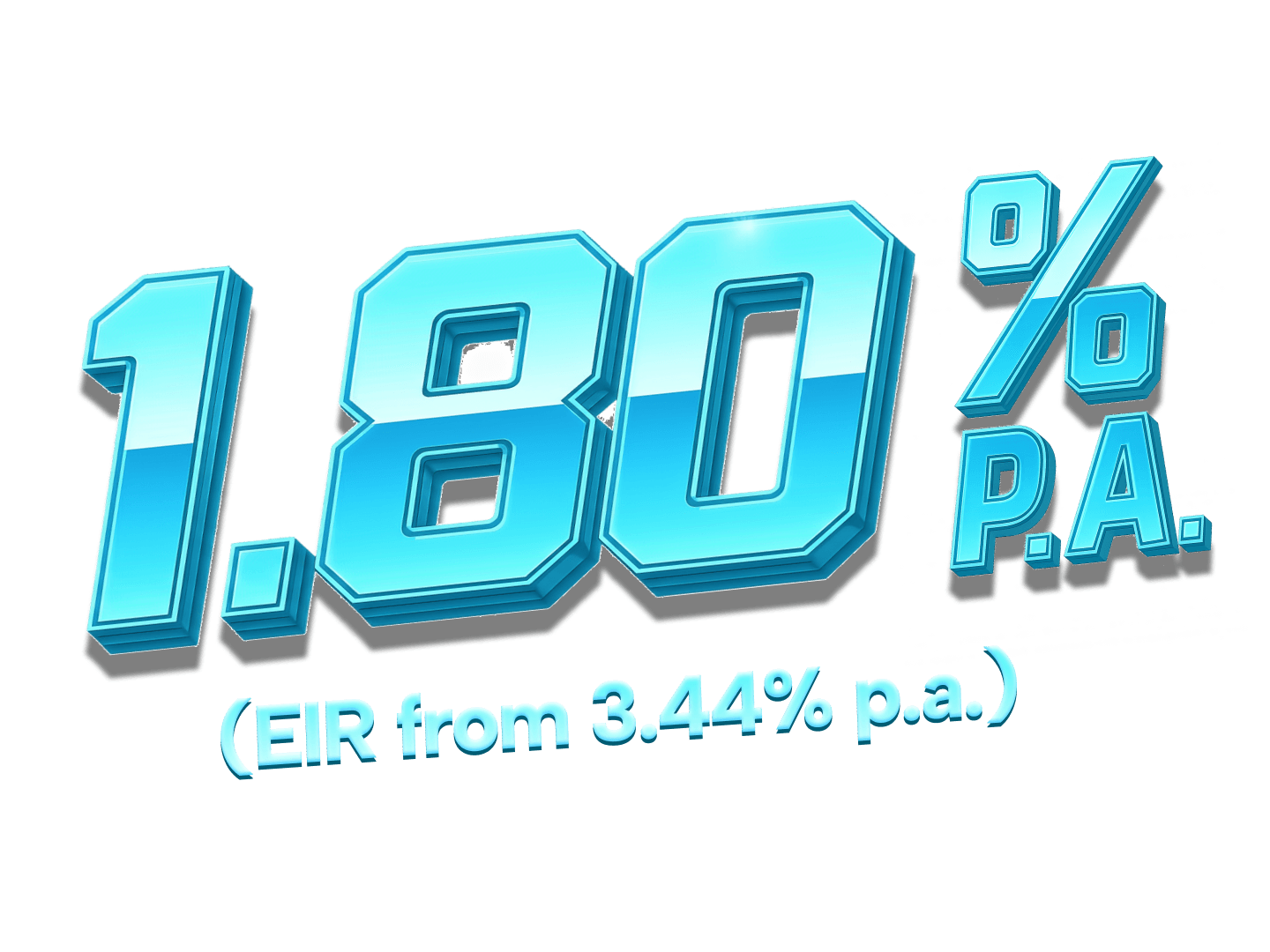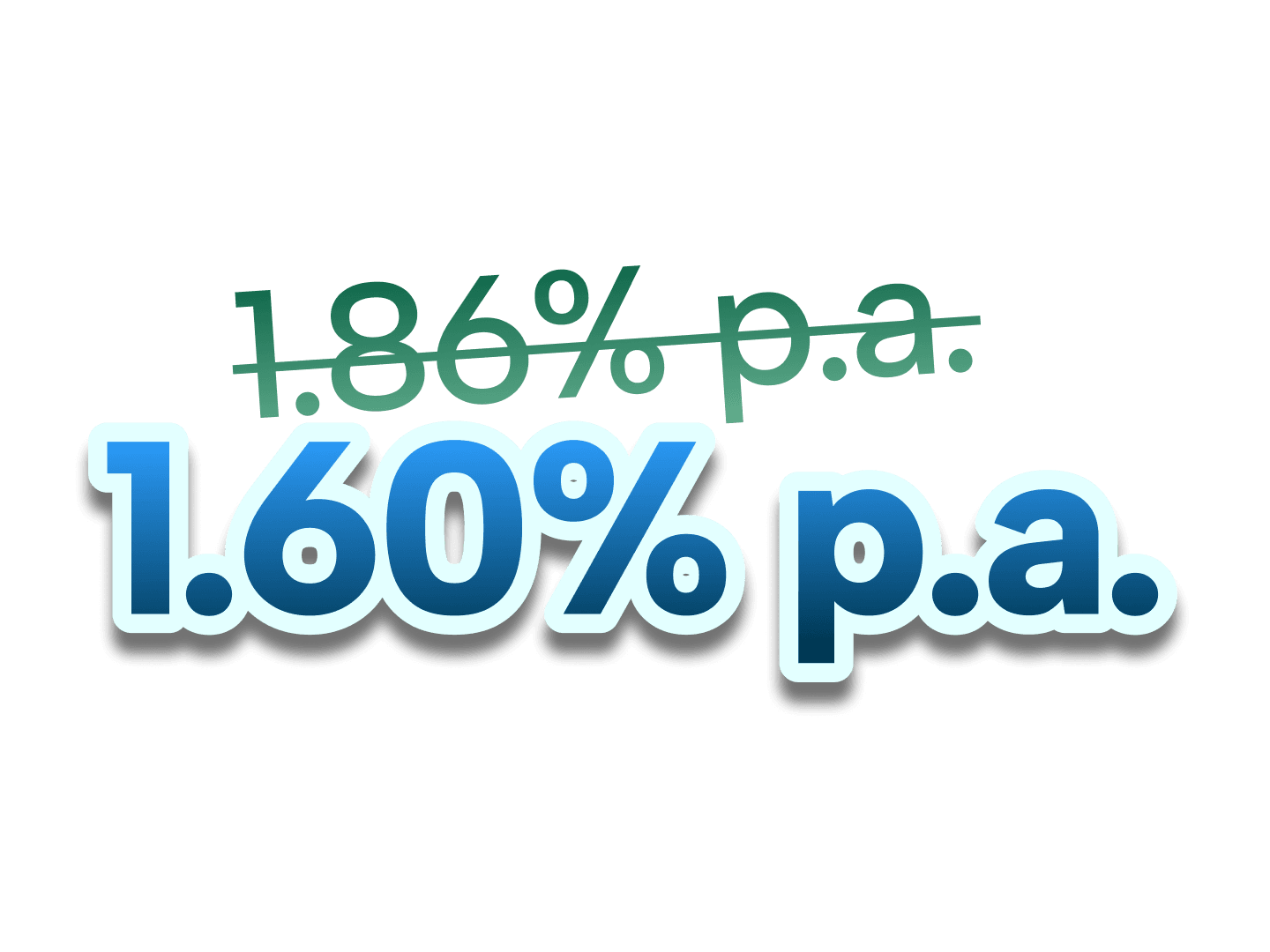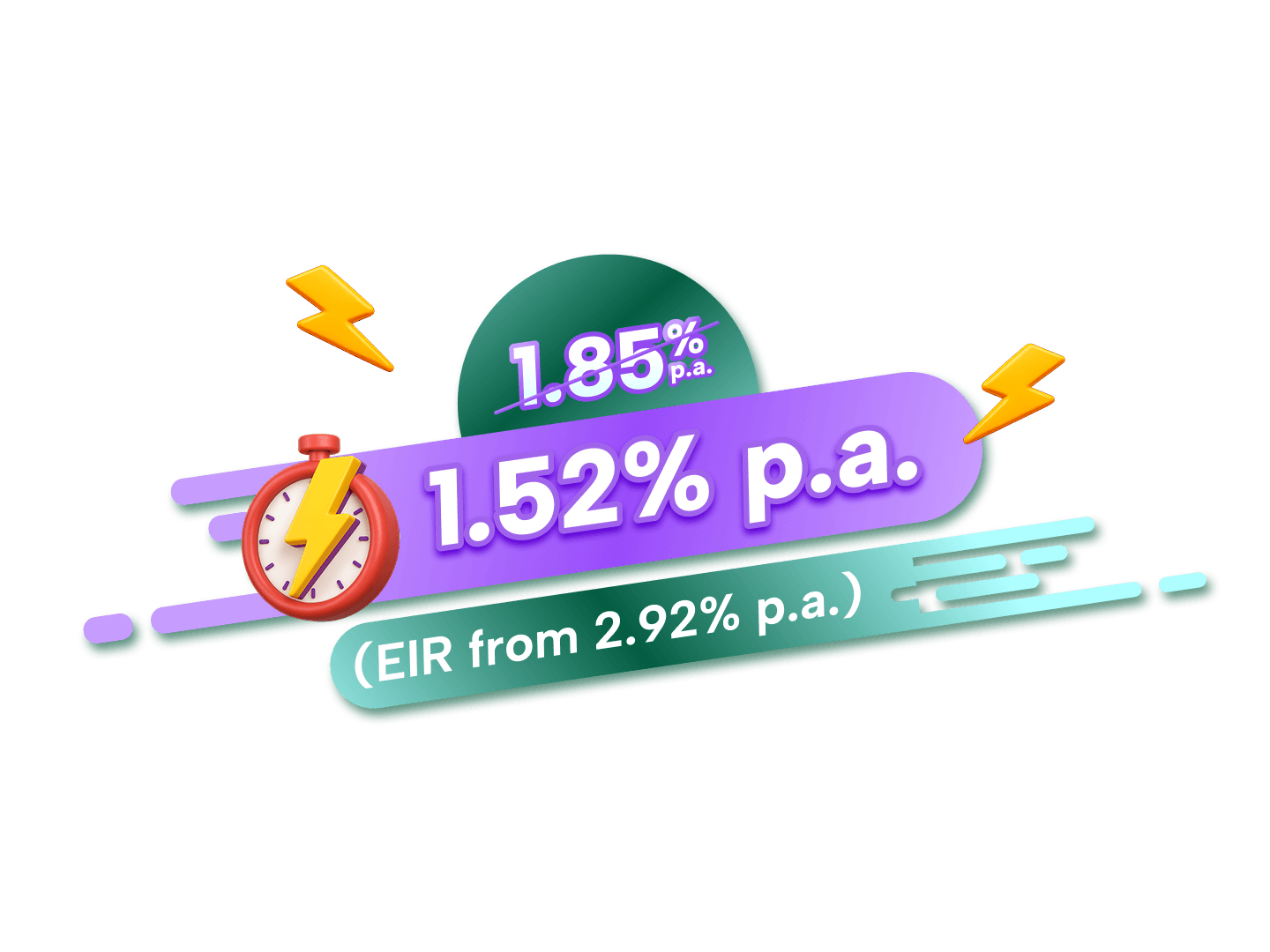How Much Renovation Loan Can I Get in Singapore?
Updated: 22 May 2025
Written bySingSaver Team
Team

No Personal Loans Match Your Criteria
Try adjusting your loan amount or tenure to see more options.The information on this page is for educational and informational purposes only and should not be considered financial or investment advice. While we review and compare financial products to help you find the best options, we do not provide personalised recommendations or investment advisory services. Always do your own research or consult a licensed financial professional before making any financial decisions.
Given the high costs of home renovations in Singapore, understanding how much renovation loan you can get will help you better plan for your home makeover.
Home renovations are costly, so planning how to fund your home makeover is an essential step. While renovation loans are affordable and convenient, they come with some drawbacks – the chief of which is the limit placed on the loan quantum.
As such, you may not be able to cover the entire cost of your renovation project with just one loan. Hence, it’s important to understand what is the maximum you can borrow and what are your options if you need to raise more funds.
⚡SingSaver x Trust Personal Loan Flash Deal⚡
Enjoy low interest rates from 1.56% p.a. (EIR from 3.00% p.a.) plus up to S$1,750 in cashback and rewards when you sign up for Trust Bank Personal Loan via SingSaver. Plus, receive a S$10 FairPrice E-Voucher from Trust when you sign up with the referral code SINGSAVE. Valid till 15 January 2026. T&Cs apply.
Here’s a detailed breakdown of which banks offer the best renovation loans in Singapore:
|
Provider |
Loan Amount (S$) |
Tenure |
Interest Rate (p.a.) |
EIR (p.a.) |
Fees |
Eligibility (Min. Income, S$) |
Link |
|
DBS |
5,000 - 30,000 |
1 - 5 years |
From 3.88% |
~7.56% |
2% handling + 1% insurance |
24,000 (SG/PR) |
|
|
UOB |
5,000 - 30,000 |
1 - 5 years |
From 2.88% |
~5.43% |
Processing fee (varies) |
30,000 (SG/PR) |
|
|
CIMB |
5,000 - 30,000 |
1 - 5 years |
From 2.98% |
~5.43% |
1.2% processing |
24,000 (SG/PR) |
|
|
Trust Bank |
1,000 - 30,000 |
1 - 5 years |
From 2.80% |
~5.28% |
3% early repayment |
30,000 (SG/PR), 60,000 (Foreigners) |
|
|
GXS Bank |
500 - 100,000 |
24 - 60 months |
From 1.88% (Reno Club) |
~3.47% |
None (late interest applies) |
20,000 (SG/PR) |
|
|
HSBC |
1,000 - 8x monthly income |
1 - 7 years |
From 2.92% |
~5.5% |
None (promotional cashback) |
30,000 (SG/PR), 40,000 (Foreigners) |
|
|
Citi |
1,000 - 4x monthly income |
1 - 5 years |
From 3.45% |
~6.5% |
None for new customers |
30,000 (SG/PR), 42,000 (Foreigners) |
|
|
GS Credit |
500 - 100,000 |
1 - 60 months |
Up to 4% / month (~48% / year) |
~20% - 60% |
~10% admin fee |
10,000 (SG/PR), 20,000 (Foreigners) |
|
|
Friday Finance |
500 - 50,000 |
1 - 36 months |
From 21.6% (1.8% / month) |
~30% - 50% |
~10% admin (50% refund on repayment) |
20,000 (SG/PR), 20,000 (Foreigners) |
|
|
Credible.sg |
500 - 50,000 |
1 - 36 months |
Up to 4% / month (~48% / year) |
~20% - 50% |
~10% admin (varies) |
10,000 (SG/PR), 20,000 (Foreigners) |
What is a renovation loan?
A renovation loan is a type of financing specifically designed to fund home improvements and renovations. Its primary purpose is to help homeowners cover the costs of upgrading or enhancing their living spaces, making it easier to transform a house into a more functional or aesthetically pleasing home without needing to tap into personal savings or other funds.
How renovation loans differ from other loans
Unlike personal loans, which can be used for a wide range of purposes, renovation loans are tailored exclusively for home-related expenses, often offering lower interest rates due to their specific use. Compared to home equity loans, which require homeowners to borrow against the value of their property and typically involve higher loan amounts, renovation loans are generally smaller, unsecured, and easier to obtain, with less stringent eligibility criteria. This makes them a more accessible option for homeowners looking to fund renovations without leveraging their property.
» MORE: How to apply for a renovation loan
Eligible renovation expenses
Renovation loans cover a variety of home improvement costs, but they are restricted to specific types of expenses. Eligible expenses typically include:
-
Electrical and wiring works: Upgrading or installing new electrical systems.
-
Built-in cabinets: Custom furniture like wardrobes, kitchen cabinets, or storage units.
-
Painting and redecorating works: Applying new paint or installing wallpaper to refresh interiors.
-
Structural alterations: Modifications to the home’s layout, such as removing or adding walls.
-
External works within the compound of the house: Improvements like driveway repairs or boundary wall enhancements.
-
Flooring and tiling: Installing or replacing tiles, hardwood, or other flooring materials.
-
Basic bathroom fittings: Upgrading sinks, toilets, or showers (excluding luxury items like jacuzzis).
However, certain expenses, such as garden landscaping or non-essential decorative items, are typically not covered by renovation loans, as they fall outside the scope of essential home improvements.
If you want to spend more on furniture and home appliances, then you would need to apply for a personal loan or find other sources of funding.
Renovation loans vs personal loans vs home equity loans
|
Criteria |
Renovation Loan |
Personal Loan |
Home Equity Loan |
|
Purpose |
Strictly for home renovations (e.g., tiling, painting, electrical works) |
Flexible use (e.g., renovations, travel, debt consolidation) |
Home renovations or other large expenses, using property as collateral |
|
Loan Amount |
Up to $30,000 or 6x monthly income, whichever is lower |
Up to $250,000 or 4-8x monthly income, depending on income level |
Up to 75-80% of property’s equity (based on market value minus mortgage balance) |
|
Interest Rate (p.a.) |
2.88%–5.88% (EIR 5.43%–10%) |
1.86%–7% (EIR 3.56%–22.34%) |
2.5%–4.5% (typically lower than personal loans) |
|
Loan Tenure |
1–5 years |
3–60 months (some up to 7 years) |
Up to 7–20 years |
|
Eligibility |
- Singapore citizen/PR |
- Singapore citizen/PR, some for foreigners |
- Singapore citizen/PR |
|
Collateral |
Unsecured |
Unsecured |
Secured (property as collateral) |
|
Disbursement |
Directly to contractor via cashier’s order |
Directly to borrower’s account |
Directly to borrower or contractor |
|
Processing Fees |
0.75%–2% of loan amount |
0%–3% of loan amount |
1%–2% of loan amount, plus valuation/legal fees |
Advantages and disadvantages of different loans
|
Loan Type |
Advantages |
Disadvantages |
|
Renovation Loan |
- Lower interest rates (2.88%–5.88% p.a.) |
- Limited loan ceiling (max $30,000) |
|
Personal Loan |
- High flexibility in fund usage (renovations, emergencies, etc.) |
- Higher interest rates (1.86%–7%, EIR up to 22.34%) |
|
Home Equity Loan |
- Lowest interest rates (2.5%–4.5%) |
- Risk of losing property if repayments missed |
When considering financing options for home renovations, selecting the right loan type depends on your specific needs and financial circumstances.
Renovation loans are best suited for small to medium projects with lower budgets, providing cost-effective financing without the need for collateral, making them an attractive option for homeowners seeking affordable improvements.
Personal loans offer greater flexibility and are ideal for individuals who don’t own property or require funds for purposes beyond renovations; however, their higher interest rates and fees make them less practical for large-scale projects.
Home equity loans, on the other hand, are well-suited for homeowners with significant equity and extensive renovation needs, allowing them to borrow against their home’s value, though they come with the risk of losing the property if repayments aren’t carefully managed, so it’s essential to do proper planning.
A line of credit can be a lifeline in emergency situations
A cashline is a flexible alternative to a personal loan that gives you access to cash up to four times your income.
How much renovation loan can you get?
In Singapore, the amount you can borrow for a renovation loan depends primarily on your monthly income, with a cap set by financial institutions. Typically, you can borrow up to six times your monthly income or $30,000, whichever is lower. For instance, if you earn $5,000 per month, you qualify for the maximum loan amount of $30,000. However, if your monthly income is $4,000, your loan limit would be $24,000 (6 x $4,000). For those earning less than $5,000 monthly, lenders may impose stricter limits, as the lower income reduces the calculated loan ceiling and may signal a higher repayment risk.
» MORE: Home renovations are generally pricey
For joint applicants, such as couples or co-owners, the loan amount is determined using the lower of the two monthly incomes. For example, if one applicant earns $6,000 and the other earns $3,000, the loan limit is based on the $3,000 income, resulting in a maximum of $18,000 (6 x $3,000). This ensures that the loan remains affordable based on the lower earner’s capacity to contribute to repayments, protecting both the borrower and the lender.
Several factors influence your eligibility for higher loan amounts. A stable and higher monthly income is crucial, as it directly impacts the loan ceiling and demonstrates repayment ability. Your credit score also plays a significant role — a strong credit history increases your chances of securing the maximum loan amount, while a poor score may lead to a reduced limit or even loan rejection. Additionally, banks like DBS or OCBC may have specific conditions, such as requiring proof of renovation (like a contractor’s quotation) or property ownership.
How is your maximum renovation loan amount calculated?
Income-based calculation
The maximum renovation loan amount is determined by multiplying your monthly income by 6, subject to a maximum cap of $30,000, whichever is lower. This ensures the loan remains affordable based on your earning capacity. For example, if your monthly income is $4,000, you could qualify for a loan of up to $24,000 (6 × $4,000). However, if your income is $6,000, the loan is capped at $30,000, not $36,000, as the cap applies universally. The $30,000 limit is set by banks to align with typical renovation costs for HDB flats or private homes in Singapore, balancing affordability with practical needs. To qualify, banks typically require proof of stable income (e.g., payslips, CPF contribution history) and may consider your overall debt obligations, such as existing loans or credit card balances, to ensure you can manage repayments.
Joint applications
For joint applicants, such as spouses or family members, the loan amount is calculated based on the lower monthly income of the applicants to ensure the loan is manageable for all parties involved. This conservative approach minimizes the risk of default by tying the loan to the financial capacity of the lower earner. For instance, if one applicant earns $5,000 monthly and the other earns $3,000, the loan calculation uses the $3,000 income, resulting in a maximum loan of $18,000 (6 × $3,000), assuming it’s below the $30,000 cap. Banks may also assess the combined credit profiles of both applicants, meaning that poor credit history from either party could affect approval or interest rates. Joint applications are common for larger renovation projects, as they allow couples or co-owners to pool resources, but the lower-income rule ensures repayments remain sustainable.
⚡SingSaver x SCB CashOne Personal Loan Flash Deal⚡
Experience the lowest interest rates from 1.80% p.a. (EIR from 3.44% p.a.) in the market, plus up to S$1,700 in Cashback when you apply for Standard Chartered CashOne Personal Loan via SingSaver. Valid till 15 January 2026. T&Cs apply.
Loan tenure and interest rates
Renovation loans typically offer a tenure ranging from 1 to 5 years, allowing flexibility to match your repayment ability. A shorter tenure (e.g., 1–2 years) results in higher monthly repayments but lower total interest paid, while a longer tenure (e.g., 4–5 years) reduces monthly payments but increases overall interest costs. For example, a $20,000 loan at 4% effective interest over 3 years might have monthly repayments of approximately $590, while over 5 years, it could drop to $360, but with higher total interest. Effective interest rates generally range from 3.5% to 5.5% per annum, depending on the lender, your credit score, and promotional offers. Some banks advertise flat rates (e.g., 2.88%), which translate to higher effective rates (around 5.3%) when accounting for how interest is calculated over the loan term. Rates may be lower for HDB flat renovations or during promotional periods (e.g., 3.5%–3.88% from banks like DBS or OCBC in 2025), but higher rates (up to 5.8%) may apply for applicants with lower credit scores or non-promotional packages.
How do joint applications for renovation loans work?
A joint application for a renovation loan in Singapore involves two or more individuals, typically spouses, family members, or co-owners of a property, applying together for a single loan to finance home renovation costs. This arrangement allows applicants to combine their financial profiles to improve loan eligibility or secure better terms. Both applicants are equally responsible for repaying the loan, and the loan is tied to the property being renovated.
Loan amount calculation for joint applicants
The loan amount for a joint application is primarily determined by the income of the applicant with the lowest income, as banks assess the repayment capacity of the weaker financial profile to ensure affordability. However, the combined income of all applicants can enhance overall eligibility, potentially allowing access to a higher loan amount or better approval chances, provided other criteria like credit scores and debt obligations are met. Typically, renovation loans in Singapore range from S$10,000 to S$30,000, with the final amount subject to the bank’s assessment of the joint applicants’ financial situation.
Renovation loans for joint applicants
For a joint application for a renovation loan in Singapore, both applicants must have strong credit scores to maximize approval chances. Banks evaluate each applicant's creditworthiness, and a poor credit score from either party can lead to rejection or less favorable terms, such as higher interest rates. A good credit score, typically above 1,800 on the Credit Bureau Singapore (CBS) scale, reflects a reliable repayment history and low credit risk. Beyond credit scores, banks consider the applicants' combined debt-to-income ratio, ensuring total monthly debt obligations do not exceed 60% of their combined income. Stable employment and Singaporean citizenship or Permanent Resident status for at least one applicant are also critical eligibility factors.
|
Application type |
Renovation loan quantum |
|
Single applicant, S$3,000 monthly income |
6x S$3,000 = S$18,000 |
|
Joint applicants - S$4,000 monthly income - S$2,700 monthly income |
12x S$2,500 = S$32,400 (capped at S$30,000) Renovation loan = S$30,000 |
How much do home renovations cost in Singapore?
With each renovation loan capped at S$30,000, you may be wondering if that would be sufficient for your needs. That’s a fair question, considering that home renovations are generally a pricey affair in Singapore.
To be sure, how much your home renovation would cost depends on several factors, including (but not limited to):
-
the size of your property
-
type of materials you want to use
-
the work required, such as hacking, carpentry and masonry
-
if there are any major repairs to do
-
electrical rewiring works
However, we can refer to online resources for a quick estimate of how much a typical home renovation may cost. Here’s some data pulled from Qanvast’s 2024 HDB home renovation cost update.
|
HDB flat type |
Estimated renovation cost |
|
3-room |
S$34,200 to S$52,100 |
|
4-room |
S$52,500 to S$66,000 |
|
5-room |
S$62,000 to S$70,000 |
Going by these figures, it would seem that relying on a single renovation loan would likely be insufficient. Hence, planning for your home renovation is crucial, allowing sufficient time to save up the funds you need.
CIMB Personal Loan Welcome Offer
Enjoy low interest rates from 1.60% p.a. (EIR from 3.07% p.a.) when you apply for a CIMB Personal Loan! Valid till 1 February 2026. T&Cs apply.
How do you get a larger loan for your renovation?
Can you borrow more than $30,000 for my renovation?
In Singapore, renovation loans offered by banks such as DBS, OCBC, and Maybank are typically capped at S$30,000 or six times your monthly income, whichever is lower, subject to credit eligibility and a Total Debt Servicing Ratio (TDSR) limit of 55%. This cap applies to both single and joint applicants, with joint applications calculating the loan amount based on the lower income of the two, up to 12 times that income, but still capped at S$30,000.
» MORE: Should you take a reno or personal loan?
However, if your renovation costs exceed this amount, several strategies can help you secure additional financing:
-
Multiple renovation loans: You can apply for renovation loans from different banks, as each bank may allow a maximum of S$30,000 per loan. For instance, taking one loan from DBS and another from OCBC could potentially provide up to S$60,000, provided you meet each bank’s eligibility criteria and stay within the TDSR limit. Some banks, like DBS, allow a maximum of two renovation loans, but the total combined amount across these loans cannot exceed S$30,000 with that bank.
-
Combining renovation and personal loans: Personal loans offer higher borrowing limits, often up to four times your monthly income for annual incomes between S$30,000 and S$119,999, or eight times for incomes above S$120,000, with caps reaching S$200,000 or more depending on the lender. For example, HSBC and Standard Chartered personal loans allow borrowing up to S$250,000. Unlike renovation loans, personal loans have no restrictions on fund usage, enabling you to cover additional renovation costs, furniture, or appliances. However, personal loans typically have higher effective interest rates (EIR), ranging from 5.5% to 15% p.a., compared to renovation loans’ EIR of 5.43% to 7.5%.
-
Loans from licensed moneylenders: Some licensed moneylenders, such as Lending Bee, offer unsecured home renovation loans up to S$300,000 with longer tenures. These loans are suitable for extensive renovations but often come with higher interest rates and stricter repayment terms. Ensure the moneylender is licensed by the Ministry of Law and carefully review terms to avoid overextending your finances.
-
Joint applicant loans: If the property is co-owned, each owner can apply for a separate renovation loan, potentially increasing the total borrowing capacity. For example, if four co-owners each secure a S$30,000 loan from different banks, the combined amount could reach S$120,000. This approach requires careful coordination and adherence to TDSR limits to avoid financial strain.
» MORE: Applying for a personal loan
Get a second renovation loan from another bank
Firstly, you can try getting a renovation loan from another bank. This will increase your total available funds up to S$60,000, as each renovation loan is capped at S$30,000.
However, you will have to look for another renovation loan package from a different bank, as you may not be allowed to borrow more than S$30,000 in renovation loans from a single bank.
DBS is explicit about this limit, and it’s likely that OCBC and Maybank – the other two banks that offer renovation loans – also have the same conditions.
To better avoid over-borrowing, consider getting your spouse or legal co-owner of your property to apply for one renovation loan each. This will help you manage your borrowing limits and prevent disruptions to your credit facilities.
Apply for a personal loan on top of your renovation loan
Alternatively, consider applying for a personal loan to supplement your renovation loan. Personal loans have no restrictions on their usage, so you can use the funds to pay for renovation work, furniture and appliances, or any mix of the two.
Another advantage of this option is that you can choose to apply for your personal loan at the same bank from which you’re getting your renovation loan. This will help make it easier to keep track of your loan repayments, as you only need to refer to one platform or bank statement.
Additionally, a personal loan can offer a higher loan amount if you’re earning a relatively high income. This is because personal loans allow you to borrow up to 4x your monthly income. If you’re earning more than S$7,500 each month, you can borrow more than S$30,000, higher than a renovation loan.
And for high-income earners (more than S$120,000 per year), banks typically allow you to borrow 8x to 10x your monthly income, making personal loans the far less restrictive option.
⚡SingSaver x UOB Personal Loan Flash Deal⚡
Get affordable interest rates from 1.52% p.a. (EIR from 2.92% p.a.) plus up to S$1,900 in cashback and rewards when you apply for a UOB Personal Loan via SingSaver. Valid till 15 January 2026. T&Cs apply.
Renovation loan eligibility criteria
To qualify for a renovation loan in Singapore, applicants typically need to meet the following criteria:
-
Citizenship: Must be a Singapore citizen or Permanent Resident (PR).
-
Age: Should be between 21 and 65 years old.
-
Property location: The property being renovated must be located in Singapore.
There are also income and credit score requirements. Banks in Singapore set specific financial thresholds to ensure applicants can repay the loan. The first one is minimum income: Most banks require a minimum annual income of S$24,000.
Another is credit score: A good credit score is essential for approval, with many banks expecting a score of at least 1,000 points. This reflects your creditworthiness and repayment history. If you don’t know your credit score, you can purchase your report at Credit Bureau Singapore.
Steps to improve chances of approval:
To increase your likelihood of securing a renovation loan, consider the following steps:
-
Check eligibility: Confirm that you meet the basic criteria (citizenship, age, and property location) and have an income of at least S$24,000 annually.
-
Maintain a good credit score: Pay bills on time, keep credit card balances low, and avoid applying for multiple loans or credit cards at once.
-
Prepare documentation: Gather necessary documents, including:
-
NRIC or passport.
-
Proof of income (e.g., payslips or tax statements).
-
Property ownership documents.
-
Renovation quotations or contracts.
-
Consider joint applications: Applying with a co-applicant who also meets the eligibility criteria can boost your chances.
-
Choose the right bank: Research banks, as some offer more flexible terms for renovation loans.
-
Plan your loan amount: Request an amount that matches your income and creditworthiness to maintain a healthy debt-to-income ratio.
Can you pay off your renovation loan early?
Loan prepayment and early settlement
Renovation loans in Singapore, structured as unsecured personal loans, generally allow borrowers to make early repayments, either through partial prepayments or full early settlement. Partial prepayment involves paying a portion of the outstanding loan balance before its due date, reducing the principal and potentially lowering future interest costs. Early settlement refers to clearing the entire remaining loan balance before the agreed tenure ends, typically ranging from one to five years. While early repayment can save on interest, especially for longer tenures, it often comes with penalties, particularly if done within a specified lock-in period.
Penalties for early repayment
Most banks in Singapore impose penalties for early repayment of renovation loans to offset the loss of expected interest income. These penalties are typically a percentage of the outstanding loan amount and vary by lender. For example:
-
DBS bank charges a prepayment fee of 1% of the outstanding loan amount for early repayment of the DBS Renovation Loan
-
OCBC bank applies a prepayment fee of 2% of the outstanding loan amount on its renovation loan. Additionally, if the repayment is made less than one month after submitting the request, an interest-in-lieu charge may apply, requiring one month’s advance notice for full redemption.
Conditions for penalties
Penalties are most commonly applied under the following conditions:
-
Lock-in Period: Many renovation loans have a lock-in period, typically one to three years, during which early repayment incurs a penalty. This period is designed to ensure banks earn a minimum amount of interest.
-
Timing of Repayment: For OCBC, repaying less than one month after submitting an early repayment request triggers an additional interest-in-lieu charge, emphasizing the need for advance notice.
-
Loan Type and Terms: Promotional loans or specific packages may have different penalty structures. For instance, some banks offer penalty-free early repayment for eco-friendly renovation loans or during limited-time promotions.
Conditions for waiving penalties
Penalties may be waived or reduced under certain circumstances:
-
Post-Lock-in period: If the loan is repaid after the lock-in period (e.g., after three years), banks like DBS and OCBC typically do not charge penalties.
-
Promotional offers: Some banks waive early repayment fees for specific loan packages, such as DBS’s Eco-aware Renovation Loan, or during promotional periods (DBS Renovation Loan).
-
Negotiation: Borrowers with a strong repayment history or those consolidating loans with the same bank may negotiate to reduce or waive penalties, though this is not guaranteed.
-
Loan tenure completion: If the loan is close to its natural end (e.g., within the last few months), some banks may waive fees, as the remaining interest is minimal.
Before opting for early repayment, consider the following:
-
Cost-Benefit Analysis: Calculate whether the interest savings from early repayment outweigh the penalty. For example, if you have a S$20,000 outstanding balance with DBS and face a 1% penalty (S$200), but early repayment saves S$500 in interest, it may be worthwhile.
-
Loan Tenure: Longer tenures (e.g., five years) accrue more interest, making early repayment more attractive, especially if penalties are low or waived.
-
Bank Policies: Policies vary significantly. For instance, TCC Credit Co-operative advertises “no hidden fees” for their renovation loans, which may imply no early repayment penalties, though this requires confirmation (TCC Renovation Loan).
-
Documentation: Early repayment often requires formal requests, such as submitting a redemption form (as with OCBC) or contacting the bank directly, which may involve processing delays.
Common mistakes to avoid when applying for a renovation loan
Overestimating the loan amount
Borrowing more than you need might seem like a safety net, but it often leads to higher interest costs and financial stress. Overborrowing means paying interest on unused funds, which could add hundreds of dollars over a five-year loan term. Plus, it increases your Total Debt Servicing Ratio (TDSR), potentially limiting future borrowing. To avoid this mistake, create a detailed budget covering materials, labor, permits, and a 10-15% contingency fund. Request quotes from at least three HDB-registered contractors to get a realistic cost estimate.
Under-budgeting
Focusing only on obvious expenses like tiles or paint can leave you blindsided by hidden costs. In Singapore, renovating a 4-room HDB flat can cost $40,000 – $80,000, depending on the scope, contractor rates, and unexpected issues like hacking or rewiring. Under-budgeting can halt your project midway, force you to compromise on quality, or push you to take additional loans at higher rates.
Applying without proper documentation
Banks in Singapore require a clear paper trail to approve renovation loans, ensuring funds are used appropriately. Missing or incorrect documents can delay approval or lead to outright rejection. A delayed loan can disrupt your renovation timeline, especially if contractors demand upfront payments. In 2022, the Monetary Authority of Singapore (MAS) tightened lending rules, making thorough documentation even more critical.
To avoid this, prepare these standard documents in advance:
-
NRIC or passport (proof of identity).
-
Recent payslips, CPF statements, or tax returns (proof of income).
-
Title deed, HDB approval letter, or tenancy agreement (proof of ownership).
-
A detailed renovation quotation from an HDB-registered contractor.
-
A signed renovation contract. Double-check for accuracy and completeness. Some banks, like Maybank, may also request additional proof (e.g., bank statements), so confirm requirements beforehand.
Not comparing loan offers
Interest rates and terms for renovation loans vary across Singapore’s lenders. For instance, DBS might offer 2.88% p.a. for eco-friendly renovations, while others hover around 4-5%. A 1% difference on a $20,000 loan over five years could mean $500+ in extra costs. Many overlook processing fees (1-2%) or early repayment penalties, inflating the true cost of borrowing.
Misunderstanding loan terms
Renovation loans come with fine print: repayment schedules, disbursement methods, and penalties. Ignoring these can lead to surprises like locked-in funds or extra fees. Some banks disburse funds via cashier’s orders to contractors, not cash to you. Early repayment might incur a 1-2% penalty on the outstanding balance, negating savings from settling early. Make sure to scrutinise the loan agreement for terms such as monthly repayment amounts and tenure, the disbursement process, and early repayment fees or lock-in periods. Ask your bank officer to clarify anything vague—don’t sign until you’re confident.
Partnering with an unreliable contractor
Not all contractors deliver what they promise. Horror stories of abandoned projects or overcharging are common, especially with unregistered firms. A bad contractor can inflate costs beyond your loan, deliver shoddy work, or delay completion, risking your loan terms. To avoid this, vet the contractors carefully.
-
Verify HDB or RADAC registration
-
Check reviews on forums like Renotalk or HardwareZone
-
Get three quotes and compare scope, not just price
-
Sign a contract with clear milestones, payment terms, and warranties
Conclusion
Renovation loans in Singapore are a cost-effective solution for homeowners looking to fund essential home improvements. By understanding loan terms, eligibility criteria, and your repayment capacity, you can finance your home transformation efficiently and affordably, turning your vision into reality without undue financial strain.
Ready to transform your home? Apply for your renovation loan through SingSaver’s comparison platform to discover the best options tailored to your financial situation. Compare interest rates, terms, and eligibility criteria from top lenders in Singapore and start your renovation journey today!
SingSaver x HSBC Personal Loan Exclusive Offer
Enjoy attractive interest rates from 1.83% p.a. (EIR from 3.5% p.a.) plus get up to S$1,100 in Cashback when you apply for HSBC Personal Loan via SingSaver. Available to new and existing customers! Valid till 1 February 2026. T&Cs apply.
Frequently asked questions about renovation loan amounts
-
Review of documents: The bank or financial institution will review the documents you submitted, such as your NRIC, income statements, proof of property ownership, and the contractor's quotation.
-
Credit assessment: They will also assess your creditworthiness based on your credit report and existing financial obligations.
-
Verification: Some lenders might contact you or your contractor for further clarification or verification of the submitted information.
-
Approval/rejection: You will receive notification, usually via mail or email, regarding the outcome of your application. The processing time can vary, but banks often take around 5-7 working days, while some licensed moneylenders might be quicker.
-
Cashier's order: If your loan is approved, the funds will typically be disbursed in the form of cashier's ordermade payable to your appointed renovation contractor, not directly to you.
-
Number of orders: Banks usually allow a limited number of free cashier's orders (e.g., the first one is free, subsequent ones incur a fee of around S$5 per order). The maximum number of orders can be around 4.
-
Disbursement schedule: You will need to coordinate with your contractor on the payment schedule and request the necessary cashier's orders from the bank accordingly.
-
Processing fee: Most banks charge a processing or administrative fee, typically a percentage of the loan amount (e.g., 1% to 2%). This fee might be deducted from the disbursed loan amount.
-
Insurance premium: Some banks may require or offer optional insurance that covers the outstanding loan in case of death or total permanent disability, with the premium (around 1% of the loan amount) deducted from the loan.
-
Other potential fees: Be aware of potential fees for late payments, early repayment, or cancellation of the loan.
-
Site inspection: Some lenders may conduct site visits after the loan has been disbursed to ensure that the funds are being used for the stated renovation works as per the quotation you provided.
-
Start of repayment: Your monthly repayments will typically start on the 1st working day of the following month after the loan is disbursed. The amount and schedule will be outlined in your loan agreement.
Yes, you can have two renovation loans in Singapore, but typically only from different banks, as most banks cap a single renovation loan at S$30,000. DBS/POSB allows a maximum of two renovation loans, provided the total does not exceed S$30,000 and is subject to credit approval. Alternatively, you can combine a renovation loan with a personal loan from the same bank for additional funds, ensuring your Total Debt Servicing Ratio (TDSR) stays below 55%.
Single applicants for renovation loans in Singapore typically need a minimum annual income of S$24,000–S$30,000, must own the property or be a family member of the owner, and can borrow up to 6 times their monthly income, capped at S$30,000. Joint applicants can borrow up to 12 times the lower monthly income, also capped at S$30,000, but must be related, with at least one owning the property and meeting combined income thresholds.
There are four stages after applying for a renovation loan.
1. Processing and Approval:
2. Loan disbursement:
3. Fees and deductions:
4. Post-disbursement:
Generally, you can expect the approval and disbursement process to take around 3 to 7 working days from the time you submit a complete application with all the necessary documents. Some banks may offer "fast-track" approval options that could potentially shorten this timeframe to as little as 2 to 3 working days for straightforward applications. However, this often depends on your creditworthiness and the completeness of your submitted documents.
For example, DBS specifies that Cashier’s Orders are issued in the contractor’s name, and borrowers can pass them to the contractor progressively based on the renovation invoice’s payment schedule. HHL Credit notes that funds may be released all at once or in scheduled phases, depending on the contract. Some lenders may conduct site visits post-disbursement to verify that the funds are used for approved renovation works, such as carpentry, wiring, or structural upgrades, and not for non-eligible items like furniture or appliances. Borrowers may incur small fees for Cashier’s Orders, and additional charges may apply for lost or excess orders.
Relevant articles
Stay ahead in everything finance
Subscribe to our newsletter and receive insightful articles, exclusive tips, and the latest financial news, delivered straight to your inbox.
About the author
SingSaver Team
At SingSaver, we make personal finance accessible with easy to understand personal finance reads, tools and money hacks that simplify all of life’s financial decisions for you.






